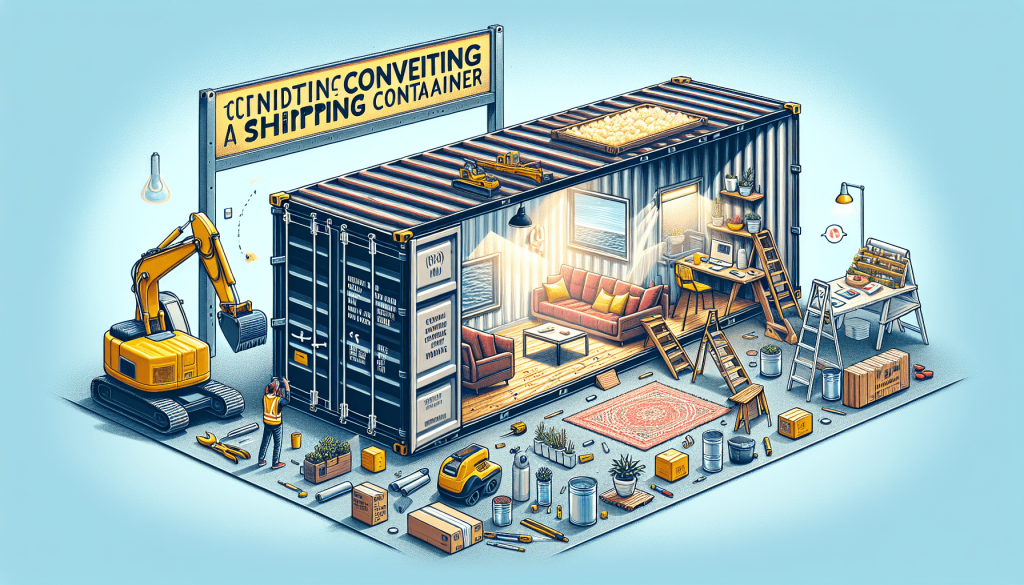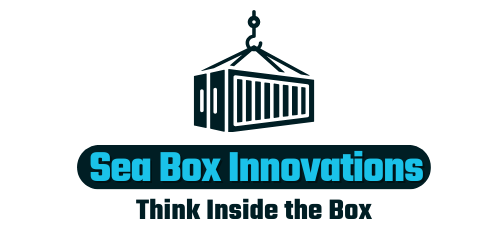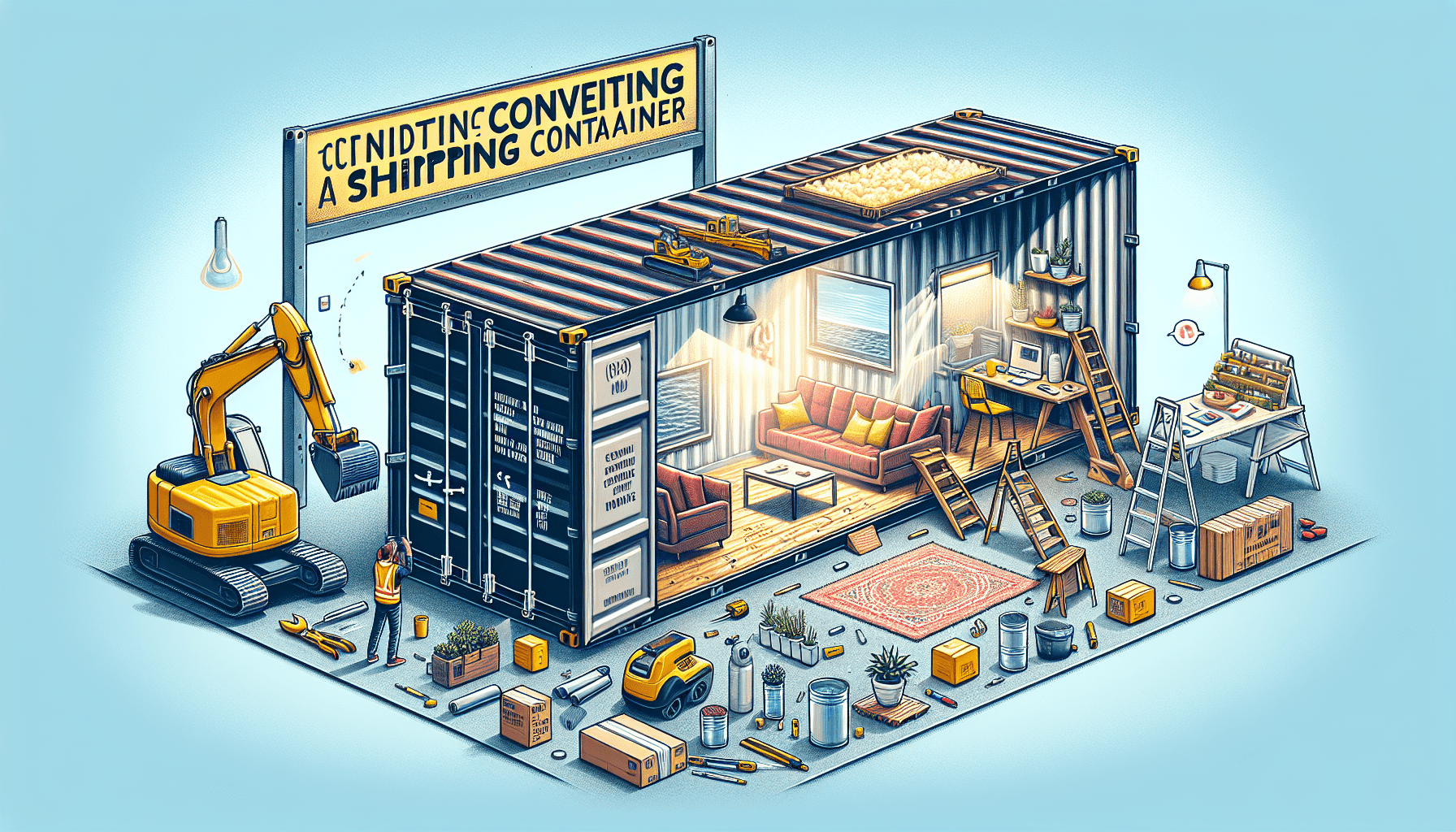Have you ever wondered how difficult it is to modify a shipping container? Well, the answer might surprise you. Modifying a shipping container is not as challenging as it may seem at first. With the right knowledge, tools, and a little bit of creativity, transforming a simple container into something functional and unique can be a fun and rewarding project. In this article, we will explore just how easy it can be to modify a shipping container and the endless possibilities that await you. So, get ready to embark on a journey of container customization and discover the world of container modification like never before.
Planning and Design
Identifying the Purpose
When considering the modification of a shipping container, it is crucial to identify the purpose of the project. Are you planning to create a living space, a workspace, or a storage unit? This step will guide the rest of the design process and ensure that your modifications align with your goals. Understanding the purpose will help you make informed decisions about the necessary structural, electrical, plumbing, and interior design modifications.
Sketching the Modifications
Once you have identified the purpose of your shipping container modification, it’s time to sketch out the modifications. Grab a pen and paper and start visualizing your ideas. Consider factors such as the placement of windows and doors, the addition of any openings, and the reinforcement that may be required. This step will help you get a clear picture of how your modified container will look and function.
Determining Budget and Resources
Before diving into the modification process, it’s essential to determine your budget and assess the resources available to you. Consider the cost of materials, labor, permits, and any professional assistance you may require. Having a budget in mind will help you make informed decisions throughout the process and ensure that your modifications align with your financial capabilities. Additionally, assess the availability of resources such as time, tools, and expertise. Understanding these factors will help you plan and execute your modification project efficiently.
Legal and Regulatory Considerations
Zoning and Building Codes
When modifying a shipping container, it is vital to consider zoning and building codes specific to your location. Each area has its own regulations regarding the use, placement, and modification of shipping containers. Research the local zoning laws and building codes to ensure your modifications comply with the necessary regulations. This step will save you from potential legal issues and ensure that your modified container is safe and in accordance with local regulations.
Permits and Inspections
In most cases, modifying a shipping container will require permits and inspections. These permits typically involve submitting a detailed plan of your modifications to the local authorities for approval. The inspections ensure that your modifications meet the necessary safety standards. It is essential to understand the permit and inspection requirements specific to your location and factor them into your project timeline and budget. Obtaining the required permits and passing inspections will provide you with peace of mind, knowing that your modifications are up to code.
Complying with Safety Standards
Safety should always be a top priority when modifying a shipping container. Ensure that your modifications comply with safety standards to protect yourself and anyone using the modified container. This may involve reinforcing the structure, installing fire-rated materials, and incorporating proper ventilation systems. Consulting with professionals knowledgeable about safety standards can provide valuable guidance and ensure that your modifications adhere to the necessary precautions.
Structural Modifications
Adding Windows and Doors
One of the common modifications to a shipping container is adding windows and doors. This transforms the container into a functional space, whether it be a home, an office, or a retail store. Consider the placement and size of the windows and doors to maximize natural light and ventilation. Reinforcing the container around these openings is necessary to maintain its structural integrity.
Cutting Openings
Sometimes, the existing openings on a shipping container may not align with the desired design. In such cases, cutting additional openings becomes necessary. However, it is crucial to plan these modifications carefully to ensure that cutting does not weaken the structure. Consult with professionals to determine the feasibility of additional openings and develop a cutting plan that maintains the container’s stability.
Reinforcing the Container
While shipping containers are designed to withstand the rigors of transportation, modifications can impact their structural integrity. Reinforcing the container ensures its stability and safety during and after the transformation process. Options for reinforcement range from adding support beams and columns to reinforcing weak areas to improve load-bearing capacity. Seeking expert advice on reinforcing techniques will help you make informed decisions to maintain the structural integrity of the container.

Insulation and Climate Control
Choosing Insulation Materials
To ensure comfort and energy efficiency in your modified shipping container, insulation is essential. There are various insulation materials available, such as spray foam, rigid foam boards, and recycled denim. Consider factors like thermal resistance, moisture resistance, and environmental impact when selecting insulation materials. It is also crucial to choose insulation materials that fit the limited space within the container while providing effective climate control.
Installing Insulation
Installing insulation requires careful planning and attention to detail. It is necessary to insulate the walls, ceiling, and floor of the shipping container to minimize heat transfer and maintain a comfortable interior environment. Follow proper installation techniques specific to your chosen insulation materials. It is advisable to seek professional assistance or consult online resources to ensure the correct installation of insulation.
HVAC Systems
Climate control is of utmost importance in a modified shipping container, especially in regions with extreme temperatures. Heating, ventilation, and air conditioning (HVAC) systems provide the desired temperature and airflow control within the container. Depending on the container’s purpose and your climate requirements, you may choose from various HVAC options, such as mini-split systems, portable air conditioners, or compact heating units. Consider factors like energy efficiency, space limitations, and maintenance requirements when selecting and installing an HVAC system.
Electrical Installations
Designing the Electrical Layout
Proper electrical planning is vital for a safe and functional modified shipping container. Designing an electrical layout involves determining the number and placement of outlets, switches, and lighting fixtures. Carefully consider the functionality and power requirements of the intended space to ensure adequate electrical supply. It is essential to abide by electrical codes and regulations to maintain safety standards.
Installing Wiring and Outlets
Installing wiring and outlets in a shipping container requires specialized skills and knowledge. It is recommended to engage a licensed electrician who can ensure the correct installation of wiring, grounding, and circuit breakers. Wiring must be protected from potential damage and routed safely within the container to avoid any hazards. Properly installed outlets will provide convenient access to power throughout the modified container.
Connecting to Power Source
Connecting your modified shipping container to a power source is a crucial step in the electrical installation process. Depending on your location and the availability of power, you have several options, such as connecting to the local power grid, using a generator, or installing solar panels. Each option has its own requirements and considerations. Consult with professionals to determine the most suitable power source for your needs.
Plumbing and Water Systems
Planning Plumbing Layout
If your modified shipping container requires plumbing systems, proper planning of the plumbing layout is essential. Consider the placement of fixtures such as sinks, toilets, and showers, and ensure they are easily accessible and functional. Plan the routing of pipes to minimize the risk of leaks, and consider the project’s water requirements when selecting the appropriate pipe sizes. Plumbing layout is crucial to achieve a well-designed and efficient water system within the container.
Installing Pipes and Fixtures
Installing pipes and fixtures requires a good understanding of plumbing principles and techniques. Seek assistance from a qualified plumber to ensure that your modified shipping container has a reliable and leak-free plumbing system. Install water supply lines, drain lines, and any necessary filtration or treatment systems. Proper installation of pipes and fixtures will ensure a functional water system that meets your needs.
Connecting to Water Supply
Connecting your modified shipping container to a water supply is necessary for plumbing fixtures to function properly. Depending on your location and the availability of water, you may need to tap into a municipal water supply, dig a well, or install a water storage system. Consult with professionals and adhere to local regulations when connecting to a water supply to ensure a safe and compliant water system within your modified container.
Interior Design and Finishing
Flooring Options
Choosing the right flooring for your modified shipping container is essential for both aesthetics and functionality. Consider factors such as durability, ease of maintenance, and the desired ambiance of the space. Popular flooring options for shipping container modifications include vinyl, laminate, hardwood, and epoxy coatings. Each option has its own advantages and considerations, so select the flooring that best suits your needs and personal preferences.
Wall and Ceiling Finishes
Transform the interior of your modified container with carefully chosen wall and ceiling finishes. Consider options such as paint, wallpaper, reclaimed wood panels, or corrugated metal sheets. Your choice of finishes will greatly impact the overall aesthetic appeal of the space. Additionally, consider the practical aspects of the finishes, such as moisture resistance and ease of cleaning. Strive to create a visually pleasing and inviting interior space by selecting suitable wall and ceiling finishes.
Customizing the Layout
One of the advantages of modifying a shipping container is the flexibility it offers in customizing the layout. You can transform the container into an open-concept space, create separate rooms, or optimize storage solutions by incorporating shelves and cabinets. Consider your specific needs and desired functionality when customizing the layout. Sketch out different arrangements and furniture placements to ensure the space is utilized effectively and meets your requirements.
Exterior Upgrades
Painting and Coating
An effective way to enhance the aesthetics and durability of your modified shipping container is through painting and coating. Choose high-quality exterior paint or specialized coatings that provide insulation, protection against rust and corrosion, and resistance to UV rays. The choice of colors and finishes will greatly impact the overall appearance of the container, allowing you to personalize and adapt it to your desired aesthetic.
Adding Exterior Cladding
Adding exterior cladding to your modified container not only enhances its appearance but also provides additional insulation and protection. There are various cladding options available, such as wood, stone veneers, metal panels, or composite materials. Consider factors like durability, maintenance requirements, and weather resistance when selecting the cladding material. With the right choice of cladding, you can create a unique and visually appealing exterior for your modified shipping container.
Enhancing Security Measures
Security should be a priority when modifying a shipping container, especially if it will contain valuable belongings or serve as a living or working space. Enhance security measures by installing proper locking mechanisms, security cameras, and alarms. Reinforce weak areas such as doors and windows to deter unauthorized access. Consulting with security experts can provide valuable insights and help you select the appropriate security measures for your modified container.
Transportation and Logistics
Preparing for Transport
If you plan to transport your modified shipping container, proper preparation is crucial. Secure loose items, protect delicate modifications, and ensure that everything inside the container is adequately packed. Pay attention to weight distribution and load-bearing capacity to minimize the risk of structural damage during transportation. Careful preparation will ensure a safe journey for your modified container.
Shipping Container Delivery
The delivery process of your shipping container will vary depending on your location and the logistics company you choose. Ensure that the delivery company has experience handling modified containers to minimize the risk of damage during transit. Coordinate with the company to provide the necessary information about the size, weight, and intended placement of the container. Professional delivery services will ensure your container arrives safely and is properly positioned on-site.
Placement and Setup
Proper placement and setup of your modified shipping container are essential to ensure stability and functionality. Consider factors such as the terrain, drainage, and proximity to utility connections when determining the container’s placement. Level the ground and ensure a solid foundation to prevent shifting or tilting. Engage professionals or experienced individuals to assist with the container’s placement and setup, ensuring it is securely anchored and ready for use.
Cost Considerations
Material and Labor Costs
Modifying a shipping container involves both material and labor costs. The cost of materials will depend on the modifications you envision, including windows, doors, insulation, electrical wiring, plumbing fixtures, and finishing materials. Labor costs can vary depending on the complexity of the modifications and whether you hire professionals or choose to tackle the project yourself. Research the prices of materials and labor in your area to estimate the total cost of your project accurately.
Professional Assistance vs. DIY
Deciding whether to hire professionals or take a do-it-yourself (DIY) approach is a crucial consideration for your shipping container modification project. Hiring professionals ensures that the modifications are done accurately and in compliance with building codes, potentially saving you time and effort. However, opting for a DIY approach can be cost-effective if you have the necessary skills, knowledge, and resources. Carefully evaluate your abilities, available time, and budget to determine the most suitable approach for your project.
Potential Hidden Expenses
When modifying a shipping container, it is important to consider potential hidden expenses that may arise throughout the process. These may include unexpected additional materials, unforeseen structural issues, or costs associated with permits and inspections. It is advisable to allocate a contingency budget to accommodate any unforeseen expenses that may arise during the modification process. Planning for potential hidden expenses will help you stay within budget and complete your project smoothly.
In conclusion, modifying a shipping container requires careful planning, design, and consideration of various aspects. From identifying the purpose of your modified container to selecting materials, obtaining permits, and considering cost implications, each step plays a crucial role in the success of your project. By following the outlined process and seeking professional advice when necessary, you can transform a shipping container into a functional and personalized space tailored to your specific needs and preferences.

I am James, the creator behind SeaBoxInnovations.com. Welcome to our premier online destination dedicated to the world of sea containers. Think Inside the Box is our tagline, and our website is your go-to source for exploring the endless potential of these versatile and adaptable containers. Whether you’re interested in purchasing, customizing, or learning about the latest trends in container architecture and design, we have you covered. Join us as we bridge the gap between traditional uses and cutting-edge applications, promoting sustainability and innovation in design and construction. Get ready to embark on your next big project with SeaBoxInnovations.com.

